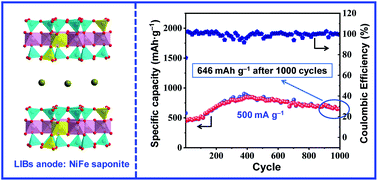NiFe saponite as a new anode material for high-performance lithium-ion batteries†
Abstract
NiFe saponite (NF-SAP) with Na+ pillaring was investigated for the first time, as a new anode material for high-performance lithium-ion batteries (LIBs). In this material, non-metallic element Si and metallic elements Fe and Ni all act as active components (providing capacity) and undergo valence state changes during electrochemical progress. Si changes between Si2+ and Si4+, while Fe and Ni transform between a nearly metallic state and Fex+ and Niy+ (0 < x < 3, 0 < y < 2). In the fully lithiated state, Ni–Ni bonds appear but only Fe–O bonds can be observed in NF-SAP. The NF-SAP/Li half cell delivers a gradually increasing specific capacity in the initial hundreds of cycles (maximum capacity of 815 mA h g−1 at the 350th cycle) and maintains a capacity of 646 mA h g−1 after 1000 cycles at 500 mA g−1. The pre-pillaring effect of Na+ is responsible for the good Li+ storage performance, which leads to the decrease of Li+ transport hindrance and high contribution of pseudocapacitance. Furthermore, a full cell of LiMn2O4/NF-SAP was assembled, which shows an initial specific capacity of 104 mA h g−1 at 100 mA g−1 and maintains a capacity of 68% after 50 cycles, demonstrating the bright application prospects of NF-SAP as a promising anode material. This work shows a new kind of anode for LIBs and provides an in-depth understanding of its energy-storage mechanism. Considering the easy preparation, low cost and environment-friendly characteristics of NF-SAP, this kind of material is applicable to large-scale energy storage.



 Please wait while we load your content...
Please wait while we load your content...